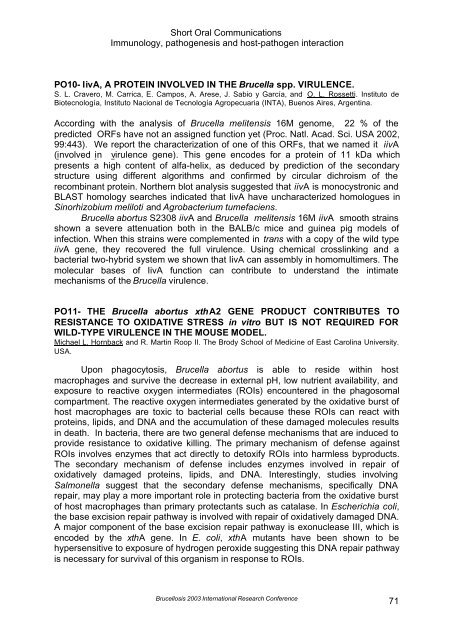Brucellosis 2003 proceedings - PHIDIAS
Brucellosis 2003 proceedings - PHIDIAS
Brucellosis 2003 proceedings - PHIDIAS
You also want an ePaper? Increase the reach of your titles
YUMPU automatically turns print PDFs into web optimized ePapers that Google loves.
Short Oral Communications<br />
Immunology, pathogenesis and host-pathogen interaction<br />
PO10- IivA, A PROTEIN INVOLVED IN THE Brucella spp. VIRULENCE.<br />
S. L. Cravero, M. Carrica, E. Campos, A. Arese, J. Sabio y García, and O. L. Rossetti. Instituto de<br />
Biotecnología, Instituto Nacional de Tecnología Agropecuaria (INTA), Buenos Aires, Argentina.<br />
According with the analysis of Brucella melitensis 16M genome, 22 % of the<br />
predicted ORFs have not an assigned function yet (Proc. Natl. Acad. Sci. USA 2002,<br />
99:443). We report the characterization of one of this ORFs, that we named it iivA<br />
(involved in virulence gene). This gene encodes for a protein of 11 kDa which<br />
presents a high content of alfa-helix, as deduced by prediction of the secondary<br />
structure using different algorithms and confirmed by circular dichroism of the<br />
recombinant protein. Northern blot analysis suggested that iivA is monocystronic and<br />
BLAST homology searches indicated that IivA have uncharacterized homologues in<br />
Sinorhizobium meliloti and Agrobacterium tumefaciens.<br />
Brucella abortus S2308 iivA and Brucella melitensis 16M iivA smooth strains<br />
shown a severe attenuation both in the BALB/c mice and guinea pig models of<br />
infection. When this strains were complemented in trans with a copy of the wild type<br />
iivA gene, they recovered the full virulence. Using chemical crosslinking and a<br />
bacterial two-hybrid system we shown that IivA can assembly in homomultimers. The<br />
molecular bases of IivA function can contribute to understand the intimate<br />
mechanisms of the Brucella virulence.<br />
PO11- THE Brucella abortus xthA2 GENE PRODUCT CONTRIBUTES TO<br />
RESISTANCE TO OXIDATIVE STRESS in vitro BUT IS NOT REQUIRED FOR<br />
WILD-TYPE VIRULENCE IN THE MOUSE MODEL.<br />
Michael L. Hornback and R. Martin Roop II. The Brody School of Medicine of East Carolina University.<br />
USA.<br />
Upon phagocytosis, Brucella abortus is able to reside within host<br />
macrophages and survive the decrease in external pH, low nutrient availability, and<br />
exposure to reactive oxygen intermediates (ROIs) encountered in the phagosomal<br />
compartment. The reactive oxygen intermediates generated by the oxidative burst of<br />
host macrophages are toxic to bacterial cells because these ROIs can react with<br />
proteins, lipids, and DNA and the accumulation of these damaged molecules results<br />
in death. In bacteria, there are two general defense mechanisms that are induced to<br />
provide resistance to oxidative killing. The primary mechanism of defense against<br />
ROIs involves enzymes that act directly to detoxify ROIs into harmless byproducts.<br />
The secondary mechanism of defense includes enzymes involved in repair of<br />
oxidatively damaged proteins, lipids, and DNA. Interestingly, studies involving<br />
Salmonella suggest that the secondary defense mechanisms, specifically DNA<br />
repair, may play a more important role in protecting bacteria from the oxidative burst<br />
of host macrophages than primary protectants such as catalase. In Escherichia coli,<br />
the base excision repair pathway is involved with repair of oxidatively damaged DNA.<br />
A major component of the base excision repair pathway is exonuclease III, which is<br />
encoded by the xthA gene. In E. coli, xthA mutants have been shown to be<br />
hypersensitive to exposure of hydrogen peroxide suggesting this DNA repair pathway<br />
is necessary for survival of this organism in response to ROIs.<br />
<strong>Brucellosis</strong> <strong>2003</strong> International Research Conference<br />
71
















